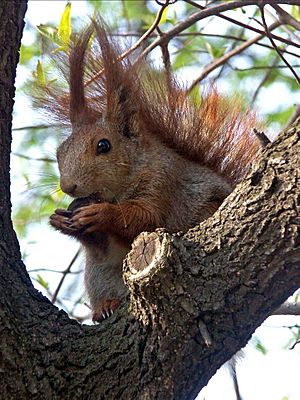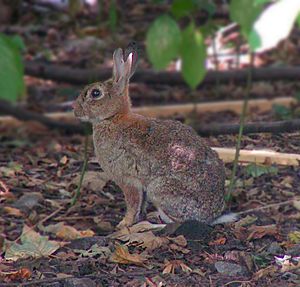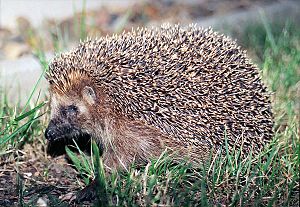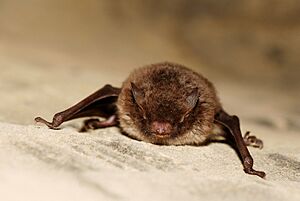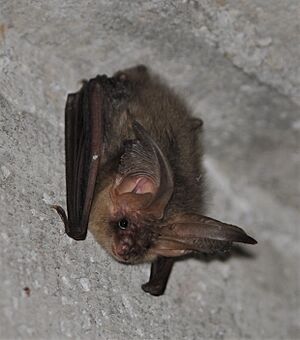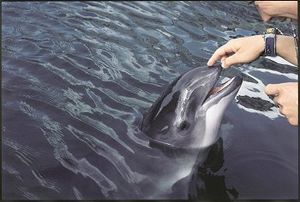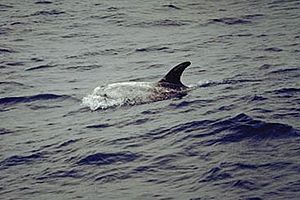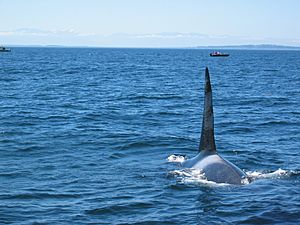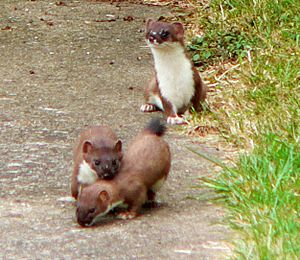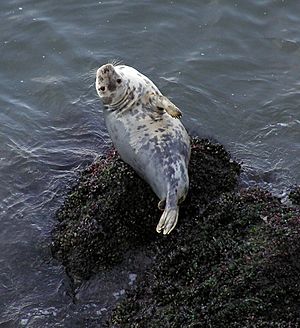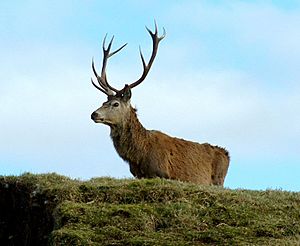List of mammals of Ireland facts for kids
Ireland is home to many amazing mammals! Before the year 1500, 27 different kinds of mammals lived here naturally or had settled in. In 2019, experts checked on these 27 species. They found that one species is now gone from Ireland, and another is at risk. But good news: 25 species are doing well! Nine other mammal species arrived in Ireland after the year 1500.
Experts use a special list called the IUCN Red List to show how safe or endangered an animal species is. Here's what the different levels mean:
| Extinct | This means the very last animal of that species has died. It's gone forever. | |
| Extinct in the wild | These animals only live in zoos or special places, or in new areas far from their original home. | |
| Critically endangered | This species is in very high danger of disappearing from the wild soon. | |
| Endangered | This species is facing a very high risk of disappearing from the wild. | |
| Vulnerable | This species is facing a high risk of disappearing from the wild. | |
| Near threatened | This species isn't in immediate danger, but it might be in the future. | |
| Least concern | There are no big worries for this species right now. It's doing fine. | |
| Data deficient | We don't have enough information to know if this species is at risk or not. |
NE means the animal is not endemic, which means it wasn't originally from Ireland.
Contents
- Marsupials: Amazing Pouched Mammals
- Rodents: The Gnawing Animals
- Lagomorphs: Rabbits and Hares
- Hedgehogs: Spiky Friends
- Shrews and Moles: Tiny Insect Eaters
- Bats: The Flying Mammals
- Whales and Dolphins: Ocean Mammals
- Carnivores: Meat Eaters and More
- Even-Toed Ungulates: Hoofed Animals
- Animals No Longer Found in Ireland
- How Ireland's Mammals Compare to Great Britain's
- See also
Marsupials: Amazing Pouched Mammals
Most marsupials, like kangaroos and wallabies, live in Australia. But one type, the red-necked wallaby, has been brought to Ireland. You can find a group of them living and having babies on Lambay Island!
- Family: Macropodidae (kangaroos, wallabies, and their relatives)
- Genus: Notamacropus
- Red-necked wallaby, N. rufogriseus NE introduced
- Genus: Notamacropus
Rodents: The Gnawing Animals
Rodents are the biggest group of mammals, making up over 40% of all mammal species! They have two front teeth in their top and bottom jaws that never stop growing. They have to keep gnawing on things to keep their teeth short.
- Suborder: Sciurognathi
- Family: Sciuridae (squirrels)
- Subfamily: Sciurinae
- Genus: Sciurus
- Subfamily: Sciurinae
- Family: Sciuridae (squirrels)
* Eastern grey squirrel, Sciurus carolinensis introduced * Red squirrel, Sciurus vulgaris
-
- Family: Cricetidae
- Subfamily: Arvicolinae
- Genus: Clethrionomys
- Subfamily: Arvicolinae
- Family: Cricetidae
* Bank vole, Clethrionomys glareolus introduced
* Wood mouse, Apodemus sylvaticus
-
-
-
- Genus: Mus
-
-
*House mouse, Mus musculus
-
-
-
- Genus: Rattus
-
-
* Brown rat, Rattus norvegicus introduced * Black rat, Rattus rattus naturalised
-
- Family: Gliridae
- Subfamily: Leithiinae
- Genus: Muscardinus
- Subfamily: Leithiinae
- Family: Gliridae
* Hazel dormouse, M. avellanarius introduced
- Suborder: Hystricomorpha
- Family: Echimyidae (spiny rats)
- Subfamily: Echimyinae
- Genus: Myocastor
- Subfamily: Echimyinae
- Family: Echimyidae (spiny rats)
* Coypu, M. coypus introduced
Lagomorphs: Rabbits and Hares
Lagomorphs include two main families: Leporidae (hares and rabbits) and Ochotonidae (pikas). They might look like rodents, but they are actually a separate group. One key difference is that lagomorphs have four front teeth in their upper jaw, not two.
- Family: Leporidae (rabbits, hares)
- Genus: Lepus
- European hare, Lepus europaeus introduced
- Mountain hare, Lepus timidus
- Genus: Oryctolagus
- European rabbit, Oryctolagus cuniculus naturalised
- Genus: Lepus
Hedgehogs: Spiky Friends
The Erinaceomorpha group has only one family, Erinaceidae. This family includes hedgehogs and gymnures. Hedgehogs are easy to spot because of their spines! Gymnures look more like large rats.
- Family: Erinaceidae (hedgehogs)
- Subfamily: Erinaceinae
- Genus: Erinaceus
- West European hedgehog, Erinaceus europaeus
- Genus: Erinaceus
- Subfamily: Erinaceinae
Shrews and Moles: Tiny Insect Eaters
These "shrew-forms" are mammals that mostly eat insects. Shrews look a lot like mice, while moles are strong, burrowing animals that live underground.
- Family: Soricidae (shrews)
- Subfamily: Soricinae
- Genus: Crocidura
- Greater white-toothed shrew, Crocidura russula introduced
- Genus: Sorex
- Eurasian pygmy shrew, Sorex minutus
- Genus: Crocidura
- Subfamily: Soricinae
Bats: The Flying Mammals
The most special thing about bats is their front limbs, which have become wings! This makes them the only mammals that can truly fly. About 20% of all mammal species are bats.
- Family: Vespertilionidae
- Subfamily: Myotinae
- Genus: Myotis
- Daubenton's bat, Myotis daubentonii
- Whiskered bat, Myotis mystacinus
- Natterer's bat, Myotis nattereri
- Genus: Myotis
- Subfamily: Vespertilioninae
- Genus: Nyctalus
- Lesser noctule, Nyctalus leisleri
- Genus: Pipistrellus
- Nathusius' pipistrelle, Pipistrellus nathusii
- Common pipistrelle, Pipistrellus pipistrellus
- Soprano pipistrelle, Pipistrellus pygmaeus
- Genus: Plecotus
- Brown long-eared bat, Plecotus auritus
- Genus: Nyctalus
- Subfamily: Myotinae
- Family: Rhinolophidae
- Subfamily: Rhinolophinae
- Genus: Rhinolophus
- Lesser horseshoe bat, Rhinolophus hipposideros
- Genus: Rhinolophus
- Subfamily: Rhinolophinae
Whales and Dolphins: Ocean Mammals
The Cetacea group includes whales, dolphins, and porpoises. They are mammals that have fully adapted to living in the water. They have a smooth, almost hairless body, a thick layer of fat called blubber, and their front fins and tail help them move through the water.
- Suborder: Mysticeti (Baleen Whales)
- Family: Balaenidae
- Genus: Balaena
- Bowhead whale, B. mysticetus vagrant (rare visitor)
- Genus: Eubalaena
- North Atlantic right whale, E. glacialis (presence uncertain)
- Genus: Balaena
- Family: Balaenopteridae (Rorqual Whales)
- Subfamily: Balaenopterinae
- Genus: Balaenoptera
- Subfamily: Balaenopterinae
- Family: Balaenidae
* Common minke whale, Balaenoptera acutorostrata * Sei whale, Balaenoptera borealis * Fin whale, Balaenoptera physalus * Blue whale, B. musculus
-
- Family: Megapterinae
- Genus: Megaptera
- Humpback whale, Megaptera novaeangliae
- Genus: Megaptera
- Family: Megapterinae
- Suborder: Odontoceti (Toothed Whales)
-
- Family: Phocoenidae (porpoises)
- Genus: Phocoena
- Family: Phocoenidae (porpoises)
-
* Harbour porpoise, Phocoena phocoena
* Cuvier's beaked whale, Ziphius cavirostris
-
-
- Subfamily: Hyperoodontinae
- Genus: Hyperoodon
- Subfamily: Hyperoodontinae
-
* Northern bottlenose whale, Hyperoodon ampullatus
-
-
-
- Genus: Mesoplodon
-
-
* Sowerby's beaked whale, Mesoplodon bidens * Gervais' beaked whale, Mesoplodon europaeus * True's beaked whale, Mesoplodon mirus
-
-
- Family: Delphinidae (marine dolphins)
- Genus: Lagenorhynchus
- Family: Delphinidae (marine dolphins)
-
* White-beaked dolphin, Lagenorhynchus albirostris
-
-
-
- Genus: Leucopleurus
-
-
* Atlantic white-sided dolphin, Leucopleurus acutus
-
-
-
- Genus: Delphinus
-
-
* Common dolphin, Delphinus delphis
-
-
-
- Genus: Tursiops
-
-
* Common bottlenose dolphin, Tursiops truncatus
-
-
-
- Genus: Stenella
-
-
* Striped dolphin, Stenella coeruleoalba
-
-
-
- Genus: Grampus
-
-
* Risso's dolphin, Grampus griseus
-
-
-
- Genus: Globicephala
-
-
* Long-finned pilot whale, Globicephala melas
-
-
-
- Genus: Pseudorca
-
-
* False killer whale, Pseudorca crassidens
-
-
- Family: Physeteridae (sperm whales)
- Genus: Physeter
- Family: Physeteridae (sperm whales)
-
* Sperm whale, Physeter macrocephalus
-
-
- Family: Kogiidae
- Genus: Kogia
- Family: Kogiidae
-
* Pygmy sperm whale, Kogia breviceps
-
- Superfamily: Platanistoidea
- Family: Monodontidae (narwhals)
- Genus: Delphinapterus
- Family: Monodontidae (narwhals)
- Superfamily: Platanistoidea
* Beluga, Delphinapterus leucas vagrant
-
-
-
- Genus: Orcinus
-
-
* Orca, Orcinus orca
Carnivores: Meat Eaters and More
The Carnivora group has over 260 species. Most of them eat meat as their main food. They have a special skull shape and teeth that help them with this diet.
- Suborder: Caniformia
- Family: Canidae (dogs, foxes)
- Family: Mustelidae (weasels, otters, badgers)
- Genus: Lutra
- European otter, Lutra lutra
- Genus: Martes
- European pine marten, Martes martes
- Genus: Meles
- European badger, Meles meles
- Genus: Mustela
- Stoat, Mustela erminea
- Genus: Neovison
- American mink, Neovison vison introduced
- Genus: Lutra
- Family: Phocidae (earless seals)
- Genus: Halichoerus
- Grey seal, Halichoerus grypus
- Genus: Phoca
- Common seal, Phoca vitulina
- Genus: Cystophora
- Hooded seal, C. cristatus vagrant
- Genus: Erignathus
- Bearded seal, E. barbatus vagrant
- Genus: Pagophilus
- Harp seal, P. groenlandicus vagrant
- Genus: Pusa
- Ringed seal, P. hispida vagrant
- Genus: Halichoerus
- Family: Odobenidae (walruses)
Even-Toed Ungulates: Hoofed Animals
Even-toed ungulates are hoofed animals. Their weight is spread almost equally on their third and fourth toes. There are about 220 different species in this group, and many are very important to humans.
- Family: Cervidae (deer)
Animals No Longer Found in Ireland
The following animal species used to live in Ireland but are now locally extinct. This means they are gone from the country:
- Wolf, Canis lupus (see Wolves in Ireland)
- Eurasian lynx, Lynx lynx
- Reindeer, Rangifer tarandus
- Wild boar, Sus scrofa
- Brown bear, Ursus arctos (see Bears in Ireland)
How Ireland's Mammals Compare to Great Britain's
Some mammal species live in Great Britain but not in Ireland. Here are a few examples:
- Field vole, Microtus agrestis
- Common vole, M. arvalis
- Water vole, Arvicola terrestris
- Harvest mouse, Micromys minutus
- Yellow-necked mouse, A. flavicollis
- Edible dormouse, Glis glis
- European mole, Talpa europaea
- Common shrew, Sorex araneus
- Eurasian water shrew, Neomys fodiens
- Lesser white-toothed shrew, Crocidura suaveolens
- Greater horseshoe bat, Rhinolophus ferrumequinum
- Greater mouse-eared bat, Myotis myotis
- Bechstein's bat, M. bechsteini
- Parti-coloured bat, Vespertilio murinus
- Serotine bat, Eptesicus serotinus
- Northern bat, E. nilssoni
- Common noctule, Nyctalus noctula
- Barbastelle, Barbastella barbastellus
- Grey long-eared bat, Plecotus austriacus
- Least weasel, Mustela nivalis
- European polecat, M. putorius
- European wildcat, Felis silvestris
- Wild boar, Sus scrofa
- Water deer, Hydropotes inermis introduced around 1896
- Eurasian beaver, Castor fiber reintroduced in 2009
See also
- List of chordate orders
- Lists of mammals by region
- Mammal classification
- Fauna of Ireland
- Deer of Ireland
- Wolves in Ireland
- Bears in Ireland


